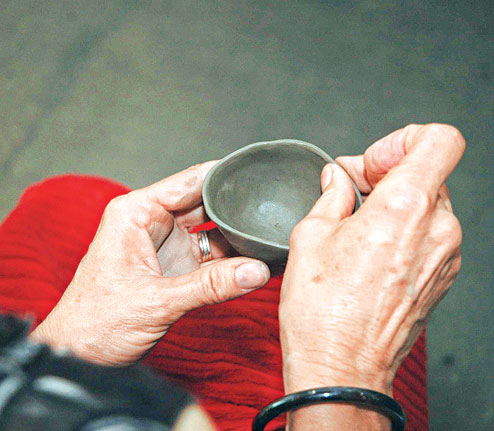
I watched Mughal-e-Azam again a month ago. 'Mughal-e-Azam' - the great Mughal. The film is one of those antediluvians, marked not only by their extinction, but by both their long duration and the grandeur of their theme. Like most historical films, it is three-quarters fiction. One isn't meant to respond to it by checking facts, but by becoming entangled in a love story, between Prince Salim (later the Emperor Jahangir) and a character who exists only in legend, Anarkali, a slave girl who became a court dancer. Their love is thwarted by Salim's father Akbar, the Mughal emperor best known for his tolerance and intellectual curiosity.
I didn't watch this film when I was a child: I must have seen it - a film intended particularly for the amplifications of the cinema-going experience - on TV when I was 18 or 19. By then, enough time had passed for it to become a 'classic'. I took in the processions of elephants and spears, the palatial pomp, which included expanses of illimitable space, authentic filigreed detail, as well as the 20th-century kitsch without which no historical setting is complete, and glorious music. But there was also an odd languor - a sense of imminent melancholy that wasn't entirely related to the story. The film's black and white photography brought to it, and its faces, a poetry that's alien to period drama. Only for about five minutes does the film become colour towards the end, during Anarkali's final dance in Akbar's court.
Part of Mughal-e-Azam's power and depth of feeling surely comes from the implicit marking by the director, K. Asif, of the disappearance of the Muslim ethos from India. India and Pakistan were created in 1947. But Mughal culture and its vestiges - its great ruins and monuments - had been in retreat since the advent of the British; Tagore's story, "Kshudito pashan" or "The Hungry Stones", about an Indian colonial increasingly possessed by a fictitious-seeming past after occupying an old Mughal mansion, is a response to his own memory of passing through such superannuated spaces during his travels as a child. "It's all illusion!" is the madman's refrain in that tale; and so it must have seemed in the decades after Independence to Asif - that the great Mughal monuments had remained, after 1947, in India, but that the Muslim elite had largely gone, and, with them, a particular lineage and consciousness.
The Mughal-e-Azam I saw a couple of months ago was the version that had been restored in 2004 and re-released to commercial success, the first Indian film to be given such a makeover. What I saw reminded me of the retouched photos I used to see in studios as a child, when people's lips and eyebrows suddenly had an incongruous sheen. There was colour everywhere now in Mughal-e-Azam; human skin, precious stones, costumes, all exhibited colour in a way that was moral in its emphasis. It was as if the restorer had wanted to improve upon the original, and instruct us that black and white was an inadequate and backward medium. The melancholy had been replaced by a kind of relentless beautification drive.
I was reminded of other things as I watched; of certain buildings I'd seen restored by conservationists in Calcutta, for instance, where restoration meant not so much repair, and a fundamental interest in, and deference to, the original structure and a period in history, as an idea of progress. With this idea came a fetishization of the new, and with the new came the imperatives of the shiny, the gleaming, and the polished. Tiles were important: often, just plain white bathroom tiles, because they shone so brightly. I have seen floors in old houses whose red oxide or other surfaces were worn after decades, and where tiles came to their rescue. In Calcutta's All India Radio building, there's a magnificently expressive bust of Tagore, the work of the painter and sculptor, Sudhir Khastgir. It has clearly been treated for decay, and polished; it now has a glaze all over it, and looks sparklingly new, like something you could buy from Gariahat Market. I'm not blaming the workman; there must be a demand for the virtues of newness.
Restoration work in Calcutta is now often based on an assumption - that an old building or object looks old today because it has aged; that it must have once looked new, or should have. I use the word 'old' here to denote three things: first, Calcutta's late 19th- and early-20th-century buildings; second, monuments, houses and objects from the pre-colonial era, going back to antiquity; third, a type of finish that controverts newness.
The houses in Calcutta that I'm thinking of - some of them colonial buildings, but most of them, certainly the most interesting ones, built by and for the Bengali middle and upper classes - are largely being demolished. Some of them, owned by families with competing stakes, are in litigious abeyance. Some of them are being maintained. A few grand buildings have been restored. Often, restoration work is equivalent to a kind of demolition; it's as if the old building had come down and an ostentatiously new one of similar proportions had risen in its place. The original features have been subdued or, possibly in the restorer's eyes, improved upon. Of course, these 'old' buildings are actually the buildings of India's, and Bengal's, modernity, which covers the period I mentioned, coterminous with the colonial city, but not contained by it, embodying a variety of architectural styles that the colonial offices, with their Palladian temple fronts and Corinthian pillars, didn't have. It's an exceptionally fertile era by any standards, in terms of Bengali writing, art, cinema, architecture, and even science. And it's a time when a particular aesthetic asserts itself in Bengal, to do with preferring earth or matt colours to artificial ones, texture to gloss, unfinishedness to completeness. Given this ethos, as well as the paradoxical spiritual effects of the industrial city, which simultaneously produced technology and decay, it's perhaps no surprise that Calcutta never looked new. Study photographs from a century ago, or look at the city's alleys and buildings in films from the 1950s, and you see that 'modernity' belies its meaning and denotes a style that's the opposite: it's not a veneer, it's not recent, but a space for, and process of, acculturation. It was born old. To restore, then, should mean giving back to the building or object its historic texture and depth of age - not to kill these fundamental features of the modern. Depth of texture needs no further illumination; it responds much better to light than a gleaming surface does.
Any exploration or tour of the country reveals that Bengali and Indian modernity takes its cue from what goes further back into the civilization: whether it's the exquisite detail of design and colour in Humayun's tomb; or the intricate stonework of Qutub Minar; or the dull beige finish of the sultanate buildings; or the dark presences of the reclining Buddhas; or the incomplete-seeming frescoes of Ajanta. The predominance of sensuous, deep surfaces; the rejection of the spectacularly representational; the tendency to hold back on colour and sheen - these are neither the result of decay and time nor of a dour religious world-view, as with English cathedrals. This is a cultural history of nuance and indirectness. It's not interested in proclaiming the new; its ambitions are different, and unique.
The Japanese novelist, Junichiro Tanizaki, in his slim 1933 book on architecture, In Praise of Shadows, makes a case for traditional Japanese aesthetics that is surprisingly akin to the delineation of a modernist credo created by the industrialized city, privileging textures produced by history and attrition: "We," he claims, contrasting Japanese and Chinese predilections with what he sees as the Western love of electricity-lit brightness, "do not dislike everything that shines, but we do prefer a pensive lustre to a shallow brilliance... that... bespeaks a sheen of antiquity..." Drolly, he adds, "Of course this 'sheen of antiquity' ... is in fact the glow of grime." Then, apologetically, he makes a bold statement: "I suppose I shall sound terribly defensive if I say that Westerners attempt to expose every speck of grime and eradicate it, while we Orientals carefully preserve and even idealize it. Yet for better or for worse we do love things that bear the marks of grime, soot, and weather, and we love the colours and the sheen that call to mind the past that made them."
Tanizaki's cultural analysis reminds us that modernism's idiosyncratic non-representational tendencies, its strange love of the unfinished, must at least partly be the consequence of the West's exposure, in the 19th century, to artworks and surfaces from 'other' lineages - to a way of imagining colour and representation, in, say, Africa, Japan, and India, that ran counter to the polished glow of Renaissance painting and sculpture. How different Tanizaki's conjecture of history's impact on us is from those who, restoring Mughal-e-Azam, unwittingly subscribe to a kitsch idea of the past that's one of the Renaissance's legacies! At what point did we begin to forget the beauty of what was close at hand?











